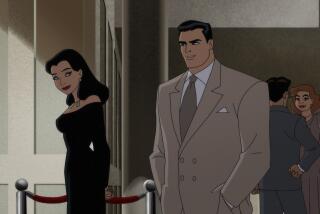Funny-book funk briefly brightens
Dying media don’t come much dying-er than monthly comic books. From the great post-silver age watershed to the who lost Junior controversy about how this classic kids’ medium became a forum for middle-aged comic-shop losers; from the death of Charlton Comics to the government war on head shops, all funny-book stories are variations on a single theme: a depletion that’s been going on so long, and moving so slowly, that nobody’s even sure if there ever was a boom time. To find a sadder tale, you’d have to look to the never-ending death of the American newspaper.
So it comes as quite a surprise to find that sales of comic books have been increasing steadily for the last five years. And that doesn’t just include graphic novelsthe perfect-bound trade paperbacks that have become the default format for the medium. Diamond Comic Distributors Inc., the company that has a practical monopoly on comics distribution, has seen improving figures in almost all formats.
What’s strange about this grim reprieve for the industry is that it is so hard to see in the popular culture. While half-century-old superheroes continue to dominate the dying medium of motion pictures, and manga and graphic novels have provided a transfusion for the dying medium of books, there’s precious little anecdotal evidence that comics are anything but moribund. If you take your kids to a comic shop (as I foolishly did a few weeks back), the cloying, creepy, did-I-accidentally-enter-a-porn-shop vibe will underscore just how empty and depressed the place is. Visit a full-service newsstand and the lone, ragged Green Lantern title brings home the grim news that there’s nothing left for the guardians of Oa to guard.
“The biggest sign that business is good is that we see articles saying business is good,” says Tom Spurgeon, former editor of The Comics Journal and proprietor of comicsreporter.com.
The problem for traditional comic books is how little they matter in pop-culture terms. Diamond’s biggest-ticket items are (except in drawing style) a world removed from the Japanese and Japanese-influenced manga books that are providing the industry’s most substantial growthand more importantly are selling well among the next generation of comics readers. If it’s striking how many movies are based on comic book properties these days, it’s even more striking how few of those properties were minted within the last decade or so.
A favorite sport of industry watchers is figuring out just how the form went from being something youthful and dynamic to becoming something fearful, risk-averse and cramped. “There was this period from about 1986 to 1993, when every single local paper had a story like ‘Local man sells Spider-Man issue No. 1 for $12,000,’” says Peter Bagge, creator of the legendary Hate comic books. “So then you had all these guys telling their sons to get into comics and buy issue No. 1 of everything. Marvel and DC exploited that by coming up with all kinds of excuses to make new No. 1s like Batman and Superman No. 1 or Superman Gets Married, and giving them alternate covers so hardcore collectors would buy every version. People were buying entire boxes of this stuff, but the collector thing was not expanding readership. When you’d hear that sales jumped from 100,000 to a million, it was still 100,000 people buying it all. And because everybody has this stuff, it’s not rare, so it never becomes valuable. So they really turned off an entire generation of comic book readers. You have some kid saying ‘I’m sitting on 50 copies of Superman Gets Married or something that nobody wants.’ And then imagine when they actually crack it open and start reading it and see what crap it is.”
That big-event marketing sensibility is classic behavior by a mature medium looking to stay on life support. And it has not died out: This year’s big superhero seller has been the death of Captain Americathe kind of marketing stunt most of us feel can only occur once.
For new material, you’ve got to look to new media, which are increasingly taking the place of serialized comics. The field of Web comics is massive, and a few people, such as Penny Arcade comics and Scott Kurtz’ PVP comicsboth opinion-leader strips focused on video gamersturn modest profits, as does Web comics publisher Joey Manley’s paid-content moderntales.com for its successful contributors. In January, R. Stevens’ long-running highly pixilated Web comic Diesel Sweeties made the jump to United Features syndication. Airship Entertainment cartoonist Phil Foglio ginned up interest in some of his less viable titles by moving them solely to the Web and making the electronic medium a loss leader for bound-book sales. Old media stalwarts are trying in their tortured way to get in on the act. IBM and DC Comics have teamed up (It’s as if stegosaurus and brontosaurus tried to mate!) to produce zudacomics.com, a site that will include new material from both professionals and amateurs.
The ultimate comics cash out is, and to some extent always has been, to generate properties that can be traded into higher-profile media. But contrast the zudacomics announcement with, for example, Kevin Spacey’s return for the next “Superman” picture and you’ll get a sense of the gap in scale you have to navigate when you need to avoid displeasing the handful of fans who still want new Aquaman comics while also satisfying the movie stars with whom you want to make big bucks. Now there’s the additional challenge of trying to find the rare gem in the vast expanse of Web comics while not abandoning the print medium entirely. That’s a lot of work just to be a feeder for higher-profile media.
“Will companies be able to translate what up until now has been a few fluke hits into a consistent revenue source?” asks Spurgeon. “Is paying a bunch of people sitting at home in their underwear a page rate to draw cartoons really the best way to find the next Harry Potter or Simpsons or Spider-Man? It’s classic big-company paranoia that they somehow might be cut out of the next pie without looking to see what the next pie looks like or how big it is.”
Tim Cavanaugh is Web editor of The Times’ editorial page. Send us your thoughts at [email protected].
More to Read
A cure for the common opinion
Get thought-provoking perspectives with our weekly newsletter.
You may occasionally receive promotional content from the Los Angeles Times.










